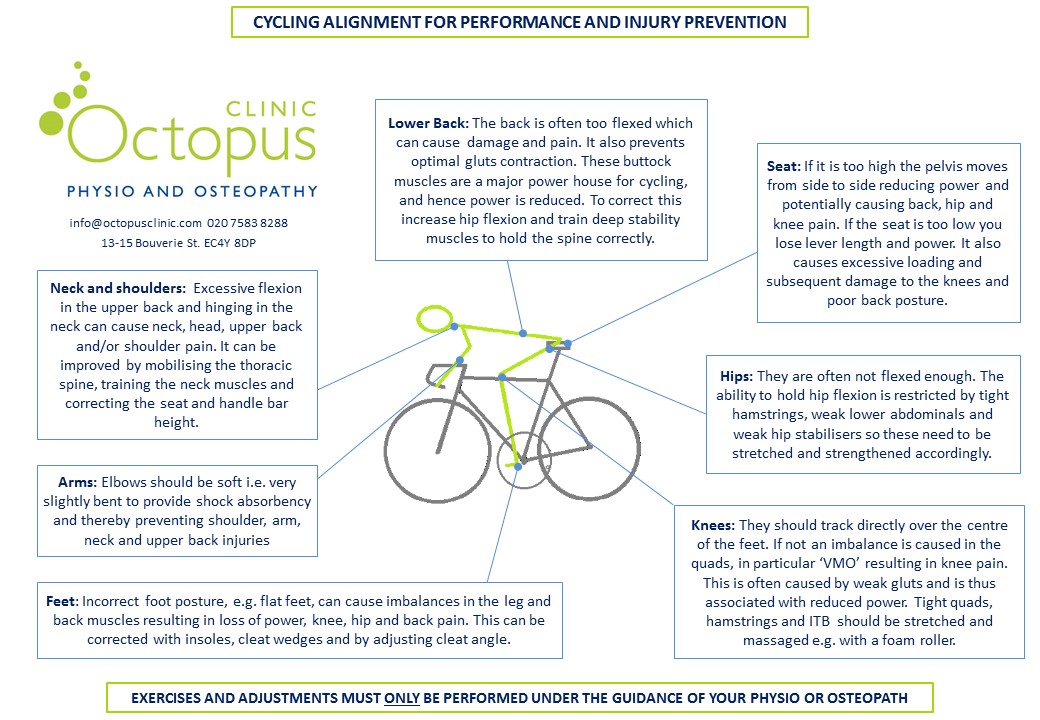Cycling
A huge number of our patients cycle either competitively or as a means of transport, we have Physiotherapists and Osteopaths that are specialists in cycling.
We provide cycling assessments so that, whether you are competing in the Etape or simply cycling to work, we know how to tweak body position and bike set up to enable recovery and improve performance.
If you have an injury you need to see an experienced Physiotherapist who will get you back on your bike ASAP.
Apart from those resulting from a fall, cycling injuries are normally as a result of:
- Incorrect body positioning or posture on the bike
- Inefficiencies in cycling technique
- Incorrect bike set up
- Weaknesses or imbalances in the muscles that enable good biking technique
- Stiffness in joints or soft tissues that prevent good bike technique
- A combination of the above
Common cycling injuries include the following.
- Pain at the front of the knee anterior knee pain which can be caused by:
- Pain at the side of the knee could be ITB friction syndrome.
- Pain in the neck or upper back could be caused by incorrect neck posture.
- Back pain, sometimes radiating into the legs could be a number of different conditions.
- Hip pain
Remember, it is important to have your pain fully assessed and treated by a Physiotherapist or Osteopath to prevent further damage occurring.
Please see below for tips on cycle set up and body positioning

-
Cervical disc injury
Cervical disc problems include degeneration, disc bulges or disc prolapses.If the discs in the neck become damaged they can bulge out and irritate or pinch the nerves coming out of the neck or the spinal cord itself. This clearly has serious implications, however can often be treated successfully with physiotherapy...
Read More -
Clicking ankles or feet
Clicking or crunching in the ankles or feet can be caused by a number of things. Most people fear that the clicking is caused by bone hitting bone. However, thankfully nowadays this is rare. If you have this, it is likely that for many years you have been suffering severe...
Read More -
Sacroiliac Joint ‘SIJ’
Problems in the joint that joins your spine to your pelvis are still hotly debated in the physio, osteo and medical worlds. Strains can occur when the ligaments supporting the joint are loose (e.g. during pregnancy or with hypermobility) and we have seen many patients with SIJ pain following a...
Read More -
Neck Pain/Tightness
Mild neck pain and/or tightness that comes on slowly is commonly due to the upper back rounding forwards and the chin pointing forwards and upwards, which increases muscle and nerve tension and may cause pins and needles or pain in the arms and hands. Sometimes, breathing becomes restricted due to...
Read More -
ITB Friction Syndrome (pain at side of knee)
Please read how the knee works before reading the following. ITB friction syndrome causes pain at the outside of the knee and may be accompanied by stiffness, giving way or a clicking sensation and is commonly worse when running, going downhill or down stairs and tender to touch. The ITB...
Read More -
Knee Braces
This information is on its way, please contact us at the clinic for more info in the meantime. We look forward to hearing from you.
Read More
Common Injuries
-
Glut/ VMO/ leg alignment exercise
Please click here to read 'how the knee works' before reading the following. This exercise trains the lateral glute muscle fibres, lower limb alignment, VMO (the inside part of the quads muscle) and stretches the calf so is a big hitter – if you can get it right! You will...
Read More -
Resisted Static Hip Flexion in Sitting
[sg_popup id="1" event="onload"][/sg_popup] Hip flexor muscle exercise and tendon loading can be brilliant for hip flexor tendon pain but must only be done under the guidance of your Physiotherapist. Please email reception@octopusclinic.com to book now. https://youtu.be/f9wYTHV2g7s
Read More -
Breathing and relaxation training
Many spinal, hip and shoulder problems can be helped by retraining breathing habits and releasing the structures involved in breathing, such as the diaphragm and thoracic spine.
Read More -
ITB and TFL release
Please click here to read how the knee works before reading the following.
Read More -
Correct your neck posture
Please read how the neck works before reading the following. The effect of gravity on the head is that it moves down and forwards, away from the body. As a result of the head being lowered it then has to be rotated upwards in order to look straight forwards not...
Read More -
Foot and ankle exercises
There are a variety of exercises that are great for your feet and ankles including: 1) Foot self-massage exercise 2) Eccentric calf strengthening 3) Foot muscles strengthening 4) Concentric calf strength and ankle instability exercise
Read More
Exercises
Related News
-
Cyclists: Optimise Your Performance, Train Efficiently and Prevent Injury with...
Get free online videos, exercises and training advice with...
Read More -
Free Online Physio Exercise Videos: Learn to train and stretch...
The eighty-seven videos include exercises for the treatment and prevention...
Read More -
Best exercises and stretches for knee arthritis or knee pain,...
Do you have knee pain, knee arthritis or knee...
Read More -
Physio kettlebell exercise video for back pain, strength and mobility
How to use kettlebells for back mobility and strength...
Read More